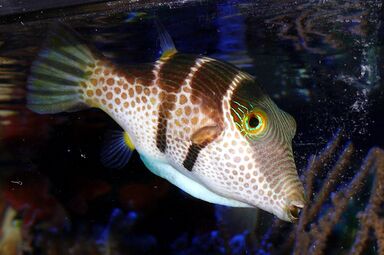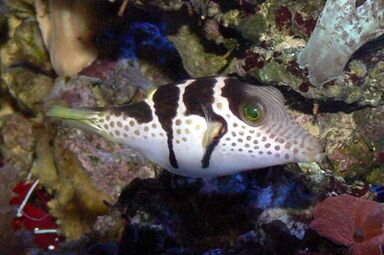Biology:Valentin's sharpnose puffer
| Valentin's sharpnose puffer | |
|---|---|

| |
| Scientific classification | |
| Domain: | Eukaryota |
| Kingdom: | Animalia |
| Phylum: | Chordata |
| Class: | Actinopterygii |
| Order: | Tetraodontiformes |
| Family: | Tetraodontidae |
| Genus: | Canthigaster |
| Species: | C. valentini
|
| Binomial name | |
| Canthigaster valentini (Bleeker, 1853)
| |
Valentin's sharpnose puffer (Canthigaster valentini), also known as the saddled puffer or black saddled toby, is a demersal marine fish belonging to the family Tetraodontidae. The saddled puffer is a small sized fish which grows up to 11 cm.[1] It is widely distributed throughout the tropical and subtropical waters of the Indian Ocean, Red Sea included, and until the oceanic islands of the Pacific Ocean.[2] It inhabits rocky and coral reefs, lagoons and external reef until 55 m.[3] Canthigaster valentini has a diurnal activity.
Canthigaster valentini has four distinct black stripes (saddles) on its back. The head is blue-grey and the main body is white speckled with blue-grey spots. The tail and fins show hints of yellow and there is a rainbow streak of color behind the eyes. It is omnivorous, it feeds on filamentous green and red algae, tunicates, and on smaller amounts of corals, bryozoans, polychaetes, echinoderms, mollusks, and brown and coralline red algae.[4]
Valentinni's sharpnose puffers are highly poisonous to eat. They are occasionally found in schools together with Paraluteres prionurus, a non-toxic filefish which has evolved to mimic the very toxic C. valentini for protection against predators.
Etymology
The puffer was named in honor of Dutch naturalist François Valentijn (1666-1727).[5]
Social groupings
Canthigaster valentini organize themselves into harems dominated by one mature territorial male and containing one or more territorial females. There may also be some immature individuals of either sex present in the dominant male's territory. Each female has her own respective domain within the territorial male's. Bachelor males, males who are sexually mature but do not inhabit a territory of their own with females, are either wanderers or live near another social group. These social groups, though male dominated, were found to be defined by the female fish living within the male's territory. Whenever a mature female dies or is in any way removed, the mature male's territory shrinks to include only the domains of the living females. When a male is removed, females remain territorial, though a bachelor male will most likely takeover any territory left undefended by a territorial male.[6]
Reproductive behavior
Canthigaster valentini are gonochoric, approximately half of the population being male and the other half being female, distinguishable by external characteristics.[7] Dominant males breed exclusively with the females in their territory and maintain territorial boundaries.[6] C. valentini's eggs are demersal, attached to algae on coral rubble. Females can lay anywhere between fifteen and over 800 eggs at a time every four to ten days depending on the season.[7] Spawning generally occurs between 8:00AM and 3:30PM year-round. After eggs are laid, no parental care is required because eggs are unpalatable and, thus, reasonably safe from predation. It was found that predatory fish would rarely attempt to eat the eggs of C. valentini and when eggs were ingested they would be quickly egested. This allows females and males to maintain their territory without the necessity of protecting their eggs as well.[8]
Eggs and larvae
Canthigaster valentini eggs range in size between 0.68 and 0.72 mm in diameter, making them some of the smallest in the family Tetraodontidae. Eggs are spherical with nine radial layers, the outermost layer possessing strong adhesive properties. After incubating for between three and five days, a relatively long incubation period for tetraodontids, C. valentini hatch around sunset at which point larvae measure between 1.30 and 1.40 mm standard length. C. valenitini's most rapid growth occurs in the 24 hours after they are hatched.[9] Growth rate then declines as fish get larger.[7] Upon hatching, larvae begin a pelagic phase that lasts between 64 and 113 days. After settlement on reefs, C. valentini are considered juveniles, having a much more robust body shape.[9]
Toxicity
The toxin found in C. valentini as well as in other pufferfish species is one of the most potent naturally occurring toxins.[10] It is a neurotoxin called tetrodotoxin present in the skin and other tissues of C. valentini. It is lethal to many species of fish, thus making C. valentini unpalatable to predators.[11] Threat of predation for adults as well as larvae and eggs is low due to unpalatability, causing reproductive behaviors to differ from other species according to the reduced predation risk.[7] Their toxic skin makes C. valentini a model for Batesian mimicry, specifically by the filefish species Paraluetes prionurus which is similarly colored, allowing it to benefit from C. valentini’s low risk of predation.[11]
Inflation response
Besides their toxicity, C. valentini have other mechanisms for evading predation. Pufferfish, as their name indicates, have the ability to ‘puff’ themselves up in order to intimidate predators. This is accomplished by filling a distensible stomach with water through rapid gulping which can increase their size to three or four times their original volume. Pufferfish must be capable of maintaining inflation for up to ten minutes in order to outlast the attention span of their predators. It was once thought that pufferfish held their breath in order to display this behavior. A 2014 study, however, found that oxygen consumption actually increases while fish are inflated. It had been previously understood that respiration through the gills ceased during inflation while cutaneous respiration increased, but this study found that cutaneous respiration is nearly nonexistent, and oxygen intake through the gills is almost five times higher than normal while C. valentini is inflated.[10]
References
- ↑ "Valentini Puffer - Canthigaster valentini - Details - Encyclopedia of Life". http://eol.org/pages/225023/details#size.
- ↑ "Valentini Puffer - Canthigaster valentini - Details - Encyclopedia of Life". http://eol.org/pages/225023/details#distribution.
- ↑ Lieske & Myers,Coral reef fishes,Princeton University Press, 2009, ISBN:9780691089959
- ↑ "Valentini Puffer - Canthigaster valentini - Details - Encyclopedia of Life". http://eol.org/pages/225023/details#trophic_strategy.
- ↑ "Order TETRAODONTIFORMES: Families TRIODONTIDAE, TRIACANTHIDAE, TRIACANTHODIDAE, DIODONTIDAE and TETRAODONTIDAE". The ETYFish Project Fish Name Etymology Database. Christopher Scharpf and Kenneth J. Lazara. 22 September 2018. http://www.etyfish.org/tetraodontiformes1/.
- ↑ 6.0 6.1 Gladstone, W. (1987-10-01). "Role of female territoriality in social and mating systems of Canthigaster valentini (Pisces: Tetraodontidae): evidence from field experiments" (in en). Marine Biology 96 (2): 185–191. doi:10.1007/BF00427018. ISSN 0025-3162.
- ↑ 7.0 7.1 7.2 7.3 Gladstone, William; Westoby, Mark (1988-03-01). "Growth and reproduction in Canthigaster valentini (Pisces, Tetraodontidae): a comparison of a toxic reef fish with other reef fishes" (in en). Environmental Biology of Fishes 21 (3): 207–221. doi:10.1007/BF00004864. ISSN 0378-1909.
- ↑ Gladstone, William (1987). "The Eggs and Larvae of the Sharpnose Pufferfish Canthigaster valentini (Pisces: Tetraodontidae) Are Unpalatable to Other Reef Fishes". Copeia 1987 (1): 227–230. doi:10.2307/1446061.
- ↑ 9.0 9.1 Stroud, Gregory J.; Goldman, Barry; Gladstone, William (1989-09-01). "Larval development, growth and age determination in the sharpnose pufferfishCanthigaster valentini (Teleostei: Tetraodontidae)" (in en). Japanese Journal of Ichthyology 36 (3): 327–337. doi:10.1007/BF02905617. ISSN 0021-5090.
- ↑ 10.0 10.1 Evelyn McGee, Georgia; Clark, Timothy (2014-12-01). "All puffed out: Do pufferfish hold their breath while inflated?". Biology Letters 10 (12): 20140823. doi:10.1098/rsbl.2014.0823. PMID 25472941.
- ↑ 11.0 11.1 Caley, M. Julian; Schluter, Dolph (2003-04-07). "Predators favour mimicry in a tropical reef fish" (in en). Proceedings of the Royal Society of London B: Biological Sciences 270 (1516): 667–672. doi:10.1098/rspb.2002.2263. ISSN 0962-8452. PMID 12713739.
External links
- http://www.marinespecies.org/aphia.php?p=taxdetails&id=219947
- Photos of Valentin's sharpnose puffer on Sealife Collection
Wikidata ☰ Q1476902 entry
 |





